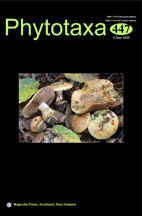Abstract
This paper reports a new Stemonitidaceae species, Stemonitis pseudoflavogenita, found in Krasnodar Territory and Novosibirsk Region of Russia. We provide morphological and molecular characterization of S. pseudoflavogenita and data on its distribution and habitat. Compared to other representatives of the genus Stemonitis, S. pseudoflavogenita and three other species of this genus (S. capillitionodosa, S. flavogenita, and S. sichuanensis) have thickening and widening of the column apex, which makes them a separate morphological group. However, the above three known species have warted and spinulose spore ornamentations, S. pseudoflavogenita shows complex ornamentation consisting of large warts and a few small warts irregularly scattered among the large ones and small indentations on the spore surface. Stemonitis capillitionodosa is a rare myxomycete. We found and retrieved the specimens of Stemonitis capillitionodosa from the Laplandskiy Biosphere Reserve (Murmansk Region, Russia), the first record of this species in Eurasia. We present a scanning electron microscopic study of both S. pseudoflavogenita and S. capillitionodosa. New sequences for SSU rDNA of S. pseudoflavogenita and S. capillitionodosa were obtained.

